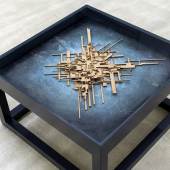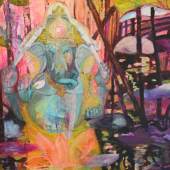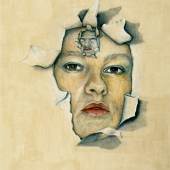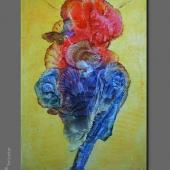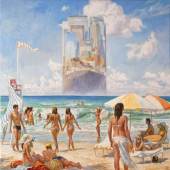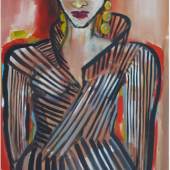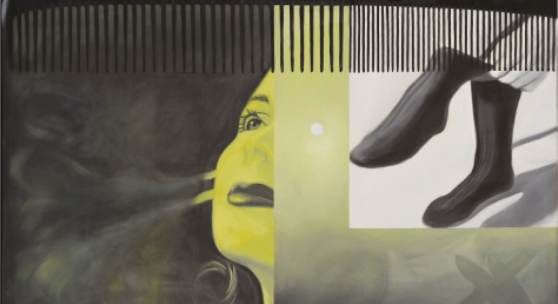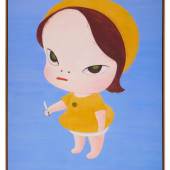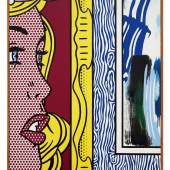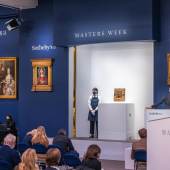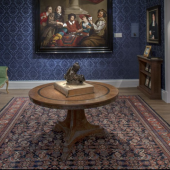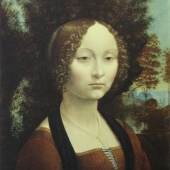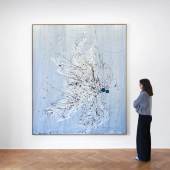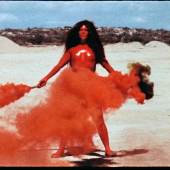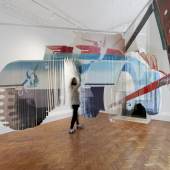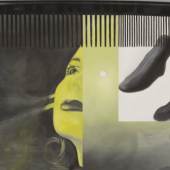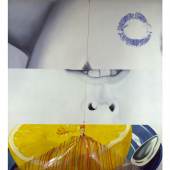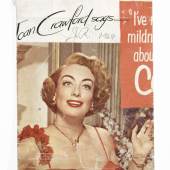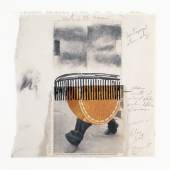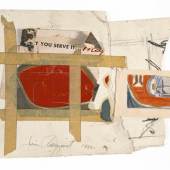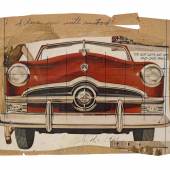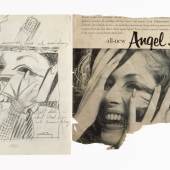James Rosenquist | Visualising The Sixties | London
-
Ausstellung10.09.2019 - 09.11.2019
Softer in palette and surreal in content, Painting with Bulb (1962) explores Rosenquist’s fascination with the image itself. Attesting to his painterly skill, Rosenquist has subtly superimposed two segments of cloudy sky to create a double framing of the central flashlight fixture. In reference to his related painting Noon (1962), Rosenquist explained, ‘I was fascinated by the fact that light can actually make things disappear’, by eclipsing all else. Employing both metaphor and paradox, Rosenquist’s lightbulb paintings place him alongside contemporaries such as Robert Rauschenberg, who used lightbulbs in a number of his famed Combines.
One of Rosenquist’s first shaped canvases and among the earliest works on display, Coenties Slip Studio (1961) presents an ambiguous, yet personal, portrait of the artist and his studio. With its title referencing the site of its production, whose East River residents also included Rauschenberg, Jasper Johns, Ellsworth Kelly and Agnes Martin, the painting is both free from explicit narrative yet suggestive and considered, exemplary of Rosenquist’s ability to create mysterious compositions that challenge viewers and render the familiar uncanny. Unlike his contemporaries, Rosenquist produced numerous works on circular or television-shaped canvases in a variety of sizes throughout the decade. In Paramus (1966) – drawn from a 1954 illustration of the three coloured beams of an RCA television – circles of magenta and blue echo the orbit of their frame, recalling the swirls of blurred colour produced by an out-of-focus lens and the peripheries – or limits – of vision.
In the mid-1960s, Rosenquist veered away from the slick realist content of his painted collages to experiment with a wider variety of abstract and spatial effects. The social and political references of these works are sometimes oblique, but they also represent a more fundamental engagement with the character of post-war image culture, ranging from Colour Field painting to television advertising ... For Rosenquist, the politics of vision lay in its capacity to lie, and the ends to which these illusions could be put. – Alex J. Taylor, Assistant Professor and Academic Curator at the University of Pittsburgh, 2019
Exemplifying Rosenquist’s pioneering engagement with newfound technologies and industrial innovations, the exhibition includes a number of works that incorporate Plexiglass, Mylar, acrylics and polythene – plastics that were still in their infancy at the time. Expanding the limits of the painted medium, the lower half of Morning Sun(1963) is encased by a sheet of painted plastic, suspended from a fishhook and twine on a bamboo stick that protrudes from the frame’s upper edge, simultaneously obscuring and transforming the subjects painted behind.
Exhibited for the first time in the UK, Forest Ranger (1967) – on loan from Museum Ludwig, Cologne – is an interactive, free-hanging painting on strips of industrial Mylar, measuring over four metres in height and explicitly designed to be walked through by visitors. Depicting a World War II armoured vehicle drawn from a General Motors Chevrolet advertisement, Forest Ranger calls into question traditional divisions between modes of viewing and environments of display. With images of forest- and carcass-cutting technologies painted upon a sliced ‘canvas’, the work attests to Rosenquist’s trailblazing position in the realms of experiential and immersive art.
The exhibition will also feature Yellow Applause (1966), a highly individual motorised painting in which two hands on separate canvases are brought together in a literal clap, enacting the actions suggested by the title. Rosenquist’s inventiveness in display, content and form across these dynamic works set him apart from the Pop artists of the time and exemplify his revolutionary explorations into art – and vision – as experience.
I want people who look at my paintings to be able to pass through the illusory surface of the canvas and enter a space where the ideas in my head collide with theirs. – James Rosenquist
Works on Paper
Brought together for this exhibition, a number of rarely shown preparatory sketches and collaged source materials provide an anthological snapshot of a defining moment in Rosenquist’s career, highlighting his eclectic approach to imagery. Ranging from densely layered sheets ripped from the pages of magazines – as with Source for The Promenade of Merce Cunningham (1963), the original collage for the Menil Collection’s painting from the same year – to sparsely arranged, isolated fragments, the collages demonstrate not only Rosenquist’s attentiveness to composition and form, but also the faithfulness of his reproductions and the bravura with which he painted. The sketches, similarly, demonstrate an attuned sensibility to craft and content, offering unique insight into Rosenquist’s radical motivations and contextualising some of his most famous works, for example, Study forMarilyn (1962), a delicate crayon and pencil study for the iconic painting Marilyn (1962), now housed in The Museum of Modern Art, New York, with later lithographs in numerous private collections as well as Tate, London.
Those advertisements had the feel of looking through a big domed mirror, where you see something close up, but it’s blurry at the edges of your peripheral vision … If I saw something like that, I’d cut it out and look at it … I wanted the space to be more important than the imagery, I wanted to use the imagery as tools … the priority for me is visual invention … content is secondary. – James Rosenquist
-
18.11.2021Sotheby’s To Announce Live Bidding Increments in Ether (ETH) Cryptocurrency For Banksy...
-
15.11.2021 - 19.11.2021Sotheby’s Lifts the Curtain onOne of the Most Important Sales Series Ever Staged $1 BILLION...
-
28.01.2022Sotheby’s New York Master Paintings and Sculpture Part ITotals $91 MillionSecond Highest...
-
Bei Leonardo da Vinci kann wohl guten Gewissens von einem Universal - Genie gesprochen werden. Da...
-
18.05.2024 - 20.07.2025Created in the artist’s studio north of Salzburg, this new series of paintings and ink...
-
21.09.2024 - 25.01.2025Group exhibition Carl Andre Joan Brown Rosemarie Castoro John Chamberlain Judy Chicago Dan Flavin...
-
21.09.2024 - 25.01.2025Carl Andre Mary Lovelace O’Neal Joan Brown Robert Morris Rosemarie Castoro Senga Nengudi...
-
28.11.2024 - 05.02.2025Marking Joan Snyder’s first solo exhibition with the gallery, Body & Soul is...
-
10.09.2019 - 09.11.2019
GALERIE THADDAEUS ROPAC
37 DOVER STREET, LONDON W1S 4NJ T +44 (0) 20 3813 8400
ROPAC.NET
OPENING HOURS TUESDAY – SATURDAY 10 AM – 6 PM
THE EXHIBITION RUNS FROM 10 SEPTEMBER 2019 – 9 NOVEMBER 2019
